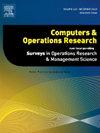Ranking methods based on the dominance degree. An investigation of rank reversal
IF 4.3
2区 工程技术
Q2 COMPUTER SCIENCE, INTERDISCIPLINARY APPLICATIONS
引用次数: 0
Abstract
Multi-criteria decision making methods have been used in many applications to derive a ranking of objects evaluated on several criteria. In case these evaluations are imprecise, integrating imprecision in the overall assessment is a further issue. In this paper, we deal with imprecise evaluations in the form of intervals. Therefore, the problem is to rank multi-dimensional interval data.
In recent years, a scoring method using the dominance degree has been proposed in order to rank interval data. This index is ordinal in the sense that it takes only into account the ordering of the endpoints of the evaluation intervals. It is computed by considering the evaluations of all the other objects to be ranked. This implies that the dominance degree, hence the ranking, may change when the set of objects to be ranked is altered. This phenomenon is known as rank reversal in the literature.
We analyze the occurrence of rank reversal when we remove an object from (or add one to) the set of objects to be ranked. We introduce variants of the dominance degree rule and analyze them similarly. This is done both analytically and by simulation. We then compare the dominance degree approach with an adaptation of the Borda rule. We also examine how the presence of a set of reference points can reduce the rank reversal phenomenon and enhance the discrimination power of the method.
基于优势度的排序方法。秩反转的研究
多准则决策方法已在许多应用中使用,以得出在几个标准上评估的对象的排名。如果这些评估是不精确的,那么在总体评估中整合不精确是一个进一步的问题。在本文中,我们以区间的形式处理不精确的评估。因此,问题是对多维区间数据进行排序。近年来,人们提出了一种利用优势度对区间数据进行排序的评分方法。这个指标是有序的,因为它只考虑了评估区间端点的顺序。它是通过考虑所有要排序的其他对象的评价来计算的。这意味着,当要排序的对象集发生变化时,支配度可能会发生变化,因此排序也会发生变化。这种现象在文献中被称为等级反转。当我们从要排序的对象集合中删除一个对象(或添加一个对象)时,我们分析秩反转的发生情况。我们引入了优势度规则的变体,并对它们进行了类似的分析。这是通过分析和模拟来完成的。然后,我们比较了优势度方法与Borda规则的适应。我们还研究了一组参考点的存在如何减少秩反转现象并提高方法的识别能力。
本文章由计算机程序翻译,如有差异,请以英文原文为准。
求助全文
约1分钟内获得全文
求助全文
来源期刊

Computers & Operations Research
工程技术-工程:工业
CiteScore
8.60
自引率
8.70%
发文量
292
审稿时长
8.5 months
期刊介绍:
Operations research and computers meet in a large number of scientific fields, many of which are of vital current concern to our troubled society. These include, among others, ecology, transportation, safety, reliability, urban planning, economics, inventory control, investment strategy and logistics (including reverse logistics). Computers & Operations Research provides an international forum for the application of computers and operations research techniques to problems in these and related fields.
 求助内容:
求助内容: 应助结果提醒方式:
应助结果提醒方式:


